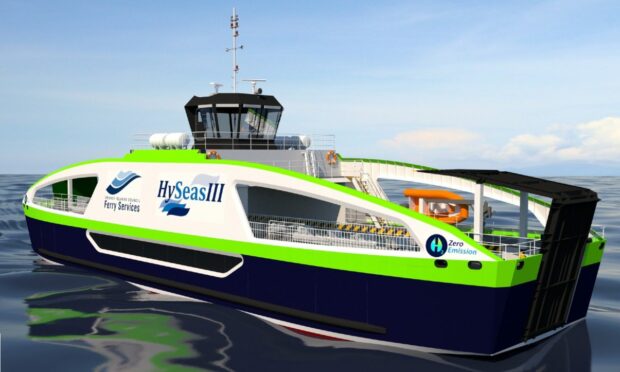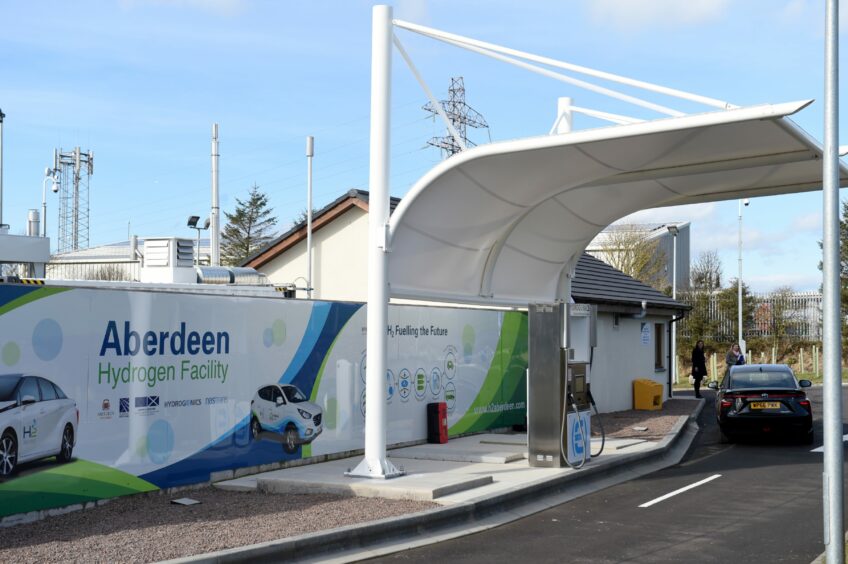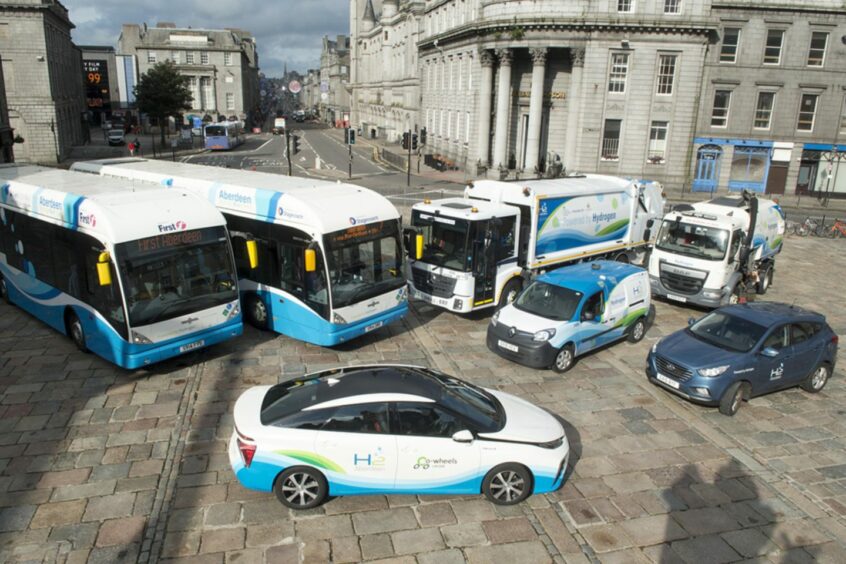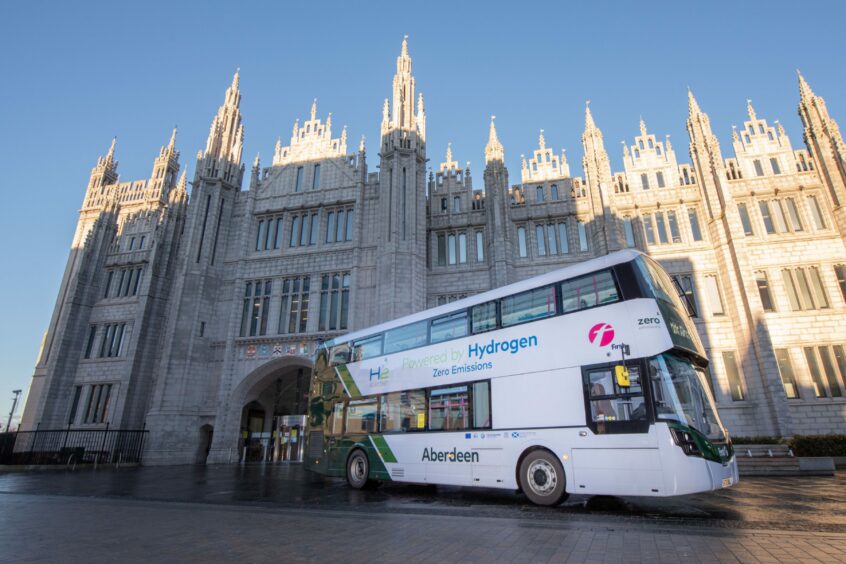Hydrogen is being touted as a fuel of the future for planes, trains, and automobiles – but when will it actually reach the mainstream and is it the right option?
There are currently a number of projects making hydrogen transport a reality across the north and north-east.
When will I be able to fly on a hydrogen-powered plane?
Under the HyFlyer II project – which brings together the European Marine Energy Centre (Emec) on Orkney, engine developer ZeroAvia and compressor company Aeristech – a 19-seater aeroplane is due to make a 350-mile test flight next year.
James McMicking, vice-president of strategy at ZeroAvia, said: “We intend to get that certified by the end of 2024 and from that period on we’ll start to roll those engines and conversions out to the fleet, and you’ll be able to go and take a flight.”
The project builds on the original HyFlyer programme, which culminated in a test flight by a six-seater plane powered by hydrogen.
ZeroAvia’s system involves compressing hydrogen gas, so it can be stored in tanks on the aircraft; the hydrogen is then combined with oxygen from the air in a “fuel cell” to produce electricity that powers a motor, which in turn drives a propeller.
In tandem, the company aims to have an 80-seater version with a 1,000-mile range ready by 2026, with a 3,000-mile version for a 200-seat aircraft following in 2035.
When will I be able to ride on a hydrogen-powered train?
In its response in July to a freedom of information request, the Scottish Government reiterated its commitment to having a hydrogen-powered train running on Scotland’s railways by 2025.
That pledge was made in its 2021 programme for government, which laid out a five-step process.
Phase two of the Scottish Hydrogen Train Project is underway at Bo’ness and Kinneil Railway, where an old diesel train – a “class 314” for trainspotters – is being converted to run off hydrogen, again using a fuel cell.
Campaign group Friends of the Far North Line wants trials of the train to take place between Thurso and Wick.
Project leader Arcola Energy, which has an engineering facility at the former Michelin tyre factory in Dundee, was bought for $40 million (£33m) last November by Nasdaq-listed Ballard Power Systems.
That takeover came just days after the hydrogen prototype had been shown off at Bo’ness for the COP26 climate change summit, while the UK’s first hydrogen-electric hybrid train – HydroFlex, from Birmingham University and train supplier Porterbrook, run by former ScotRail boss Mary Grant – was displayed at Glasgow Central station.
When will I be able to hail a hydrogen-powered taxi?
Hydrogen-powered taxis could soon be returning to the streets of the Granite City.
A trial took place four years ago with a left-hand drive Hyundai ix35 car, which filled up at the Aberdeen City Hydrogen Energy Storage refuelling station.
With the recent introduction of the city’s low-emission zone, hydrogen cabs could now mount a comeback.
“Initial discussions have been held via our licensing committee on the possibility of re-introducing hydrogen fuel cell taxis to Aberdeen’s taxi fleet as more suitable right-hand drive fuel cell electric vehicles have now become available on the market,” said the city council.
For the past eight years, the council has been running a fleet of hydrogen-powered vehicles, which currently consists of cars – a mix of Hyundai Nexo and Toyota Mirai – vans, buses, road sweepers and a new bin lorry.
Some of the cars are leased to other organisations in the city, including the car club, with Enterprise taking over from Co-wheels last month.
When will I be able to hop on a hydrogen-powered bus?
In Aberdeen you already can – 10 hydrogen buses began trundling along the city’s streets back in 2015.
They were followed last year by the world’s first hydrogen-powered double-deckers.
The latest 15 vehicles, made by Wrightbus in Northern Ireland, were taken out of service in the spring after an engineer found a problem with their mounting brackets, but they’re now back on the road.
They operate on services 17 and 18, which link Dyce to Kincorth via the city centre, and service 19 between Tillydrone and Peterculter through the centre.
Again, the buses are powered by hydrogen fuel cells.
First Bus worked on the deployment of the double-deckers with Aberdeen City Council as part of the Joint Initiative for hydrogen Vehicles across Europe project.
Wrightbus was rescued from administration in 2019 by Jo Bamford, heir to the JCB digger empire, and has since grown its workforce from 56 people to more than 900.
When will I be able to sail on a hydrogen-powered ferry?
The HySeas III project – a Europe-wide scheme involving Orkney Islands Council, St Andrews University and Caledonian Maritime Assets (CMAL), which owns the ferries, ports, harbours and other infrastructure used to run services on the west coast, in the Firth of Clyde and in the Northern Isles – is coming to its conclusion.
The design for a small ferry powered by a hydrogen fuel cell recently received accreditation from the DMV classification society, with the project’s final meeting due to take place in Brussels during September.
“We’ll obviously be keen to get funding from the Scottish Government through Transport Scotland to take this to a build at some stage,” explained John Salton, CMAL’s fleet manager and project director.
If funding can be found next year and hydrogen fuel cell developers receive regulatory approval for their batteries to be used at sea, a ferry could enter production in 2024.
Orkney’s Kirkwall to Shapinsay lifeline service is likely to be the first route for a Scottish hydrogen-fuelled ferry, which could come as early as 2026.
But is hydrogen the answer?
Questions still remain over whether hydrogen is the most suitable way to decarbonise transport.
Tom Baxter, a consultant and visiting professor at Strathclyde University, warned hydrogen was a distraction from electrification and improving energy efficiency.
He argued the focus should remain on electrification, with developments in technology allowing batteries to be used for lorries and buses.
At sea, Mr Baxter thinks batteries will also be used for near-shore journeys, such as ferries, and that methanol rather than hydrogen or ammonia will become the fuel for cargo ships and larger boats.
“Ammonia troubles me because of its toxicity and it really is a very poor fuel,” he said.
Mr Baxter suggested biofuels should be ring-fenced for use in aviation, which he pointed out accounts for only 2-3% of global carbon emissions.
He also highlighted figures from Network Rail that estimated hydrogen would play a role on only 560 of the 9,570 single-track miles on UK lines that weren’t already electrified.
“The west coastline and lines like that are not big carbon emitters,” he said.
Mr Baxter added: “The case for hydrogen is evidence-weak – what’s good for big business is not necessarily what’s good for the electorate or the consumer.”






Conversation